支气管扩张合并鸟分枝杆菌复合肺部感染患者误吸的支气管镜检测
IF 1.8
4区 医学
Q3 RESPIRATORY SYSTEM
引用次数: 0
摘要
目的探讨胃食管反流合并喉咽反流和误吸是否在支气管扩张和鸟分枝杆菌复合体(MAC)肺部感染的发病机制中起作用。方法本前瞻性病例对照研究纳入31例支气管扩张患者行支气管镜检查疑似MAC感染,9例对照组因其他原因行支气管镜检查。患者在支气管镜检查前一晚饮用45毫升FD&;C Blue #1与200毫升自来水混合。支气管镜检查时,检查支气管黏膜是否有蓝色染色。支气管肺泡灌洗液(BAL)在CT扫描上从最受影响的节段获得,进行分枝杆菌培养和胃蛋白酶和胆汁酸检测。结果93.8%的确诊肺MAC感染患者和91.7%的CT扫描支气管扩张患者有支气管粘膜蓝色染色,但分枝杆菌培养阴性,对照组为11.3% (p <;0.001)。在100%的MAC患者和90.9%的支气管扩张和分枝杆菌培养阴性的患者中,CT上的异常区域与支气管镜显示蓝色染色的气道相关。与合并MAC阴性患者(支气管扩张和分枝杆菌培养阴性的受试者和真正的对照组)相比,MAC患者的中位BAL胃蛋白酶水平更高,分别为5.4 ng/mL和3.4 ng/mL (p = 0.019)。78.6%的MAC患者与26.3%的联合MAC阴性患者BAL胆汁酸浓度为>;/= 0.493 uM (p = 0.005)。MAC阳性与MAC阴性患者在年龄、声门上指数、反流症状、胃pH值或质子泵抑制剂使用方面无显著差异。42.8%在BAL上有MAC生长的患者在胃吸液中也有MAC生长。结论胃内容物反流和吸入气道与支气管扩张密切相关,并可能与MAC肺部疾病有关。本研究中介绍的在支气管镜检查前晚上饮用蓝色染料的新方法应用于评估可能与误吸有关的感染性和炎症性肺部疾病。本文章由计算机程序翻译,如有差异,请以英文原文为准。
Bronchoscopic detection of aspiration in patients with bronchiectasis and Mycobacterium avium complex pulmonary infection
Rationale
To investigate whether gastroesophageal reflux with laryngopharyngeal reflux and aspiration play a role in the pathogenesis of bronchiectasis and Mycobacterium avium complex (MAC) pulmonary infection.
Methods
In this prospective case-control study, subjects included 31 patients with bronchiectasis undergoing bronchoscopy to investigate suspected MAC infection and 9 control subjects undergoing bronchoscopy for alternative reasons. Patients drank 45 mL of FD&C Blue #1 mixed with 200 mL of tap water the night prior to bronchoscopy. During bronchoscopy, the bronchial mucosa was inspected for the presence of blue dye staining. Bronchoalveolar lavage (BAL) samples were obtained from the most affected segments on CT scan and were cultured for mycobacteria and assayed for pepsin and bile acids. Gastric aspirate samples were obtained for mycobacterial culture.
Results
93.8% of patients with confirmed pulmonary MAC infection and 91.7% of patients with evidence of bronchiectasis by CT scan, but negative mycobacterial cultures, had blue dye staining of the bronchial mucosa vs. 11.3% of control patients (p < 0.001). Areas of abnormality on CT correlated with airways demonstrating blue staining by bronchoscopy in 100% of MAC patients and 90.9% of patients with bronchiectasis and negative mycobacterial cultures. MAC patients had higher median BAL pepsin levels compared to combined MAC negative patients (subjects with bronchiectasis and negative mycobacterial cultures and true controls), 5.4 ng/mL vs. 3.4 ng/mL (p = 0.019). 78.6% of MAC patients vs. 26.3% of combined MAC negative patients had BAL bile acid concentrations of >/= 0.493 uM (p = 0.005). There was no significant difference in age, supraglottic index, reflux symptoms, gastric pH, or proton pump inhibitor use between the MAC positive vs. MAC negative patients. 42.8% of patients with growth of MAC on BAL also had growth of MAC in the gastric aspirate.
Conclusions
Reflux and aspiration of gastric contents into the airways show a strong association with bronchiectasis and may be associated with MAC pulmonary disease. The novel method introduced in this study of drinking blue dye the evening prior to bronchoscopy should be utilized in the evaluation of infectious and inflammatory lung diseases in which aspiration may play a role.
求助全文
通过发布文献求助,成功后即可免费获取论文全文。
去求助
来源期刊

Respiratory Medicine and Research
RESPIRATORY SYSTEM-
CiteScore
2.70
自引率
0.00%
发文量
82
审稿时长
50 days
 求助内容:
求助内容: 应助结果提醒方式:
应助结果提醒方式:


